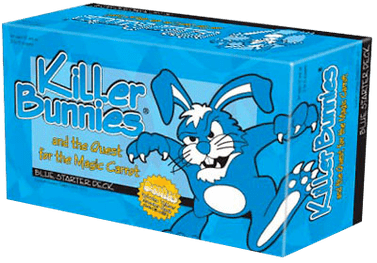Designer(s) Jeff Bellinger Players 2–8 Setup time 15 minutes | Publisher(s) Playroom Entertainment Age range 12+ Playing time | |
 | ||
Killer Bunnies and the Quest for the Magic Carrot is a noncollectible card game created by Jeff Bellinger and graphic design/illustrations by Jonathan Young. Some early artwork for the game was also done by "Alex" Alexander, although credit for his contributions are not generally recognized. It is published by Playroom Entertainment.
Contents
Gameplay
The objective of the game is to win, accomplished by acquiring carrot cards, one of which is revealed to be the winning "magic carrot" at the end of the game. The player with the winning carrot card must also have an alive bunny in the Bunny Circle. Acquiring carrot cards is done primarily through the use of bunnies, which allow the use of an enormous variety of in-game actions. Thus, the game revolves around playing bunnies and eliminating opposing bunnies through various means (some comical and some violent, but the game art never shows blood or gore).
Each player maintains a hand of five cards and a run cycle of two cards. In each turn, players normally turn the Top Run card face up to play it, then slide the Bottom Run card into the Top Run position, draw a replacement card, and place a card from their hand into the Bottom Run position, thus returning their hand size to five cards.
Cards may be one of different varieties: "Run" cards are the basic type of cards, while "Special" cards are those that may be either played normally, or may be saved for later use when put through the run cycle. "Very Special" cards are similar, except that the player may choose to play the card out of turn, immediately from their hand. There are also the "Play Immediately" cards, which are played whenever they are drawn. Finally, "Kaballa Dolla" cards represent the monetary currency in the game, which may be used to purchase various items at the start of the player's turns.'
Expansions
Killer Bunnies consists of a 110-card starter deck, as well as Cabbage and Water cards, and 6 twelve-sided dice. Booster sets containing 55 additional cards and other equipment have been released, adding to the complexity of the game. As of the Epsilon revision of the game, Killer Bunnies includes the first booster set. Due to its nature as a noncollectible card game, each expansion relies on gameplay elements found in previous expansions, prompting players to own every previous booster set before acquiring the next one. Some have criticized the piecemeal release, although it is not atypical of collectible card games, to which Killer Bunnies retains a passing resemblance. However, Killer Bunnies and its booster decks were originally designed together, with certain components referencing or referring to mechanics found in later booster decks. There are a total of 10 booster decks (not including the Yellow booster which now is included with the Blue starter):
In addition, "Bunny Blanks" are also available, which allow players to create their own cards. Limited edition "Omega series" cards have also been released, providing a collectible aspect to the game. The "Psi series" cards, included with the Bunny Blanks, are also a second series of collectible Killer Bunnies cards.
Kids Game
In 2004, the kids version of Killer Bunnies, Kinder Bunnies: Their First Adventure, was released. It is a very simplified and largely nonviolent game, created for children as young as five years old. The Sky Blue Starter Deck has very little reading and just a series of basic cards. The Sunshine Yellow Booster Deck (included in the same box as the Starter Deck) requires more reading and may not be suitable for the younger kids. There are no other booster decks available for this game. However the Kinder Bunnies cards can also be added to the Killer Bunnies cards as an eleventh booster deck.
Criticism
The most common criticism of Killer Bunnies is that the game is ultimately a lottery, with the winner being determined by the random choosing of the Magic Carrot, which is set at the start of the game. Because of this, a player consistently outclassed through the game can still win as long as a single bunny and a single carrot card is retained. Fans of Killer Bunnies contend that this random element keeps the game exciting even when one player's early card draws leave him in a poor position. It also allows less skilled or serious players to enjoy a game against more experienced players. Others have complained about the complexity of Killer Bunnies, especially with the booster packs added to the game.
There are, however, alternate rules that allow for a non-random endgame. Points are assigned for each Carrot that a player has acquired, and the "Magic Carrot" is worth a slightly higher point value. This way, a player with only the Magic Carrot can still be beaten by a player that has dominated the game with collecting many Carrots.
Sequels
Sequels to the original Killer Bunnies game have been released. Killer Bunnies and the Journey to Jupiter was released in October 2008. There is also a third game in the series by the name of Killer Bunnies and the Ultimate Odyssey that was released in 2010. Odyssey, like the others, is non-collectible and constructible. However, in order to fulfill players' desires for less randomness, it involves players building their own unique decks to draw from, instead of drawing from a central pile. Playroom Entertainment has also released Killer Bunnies and the Conquest of the Magic Carrot. It is a new version of the original and is completely compatible with the Quest for the Magic Carrot.
